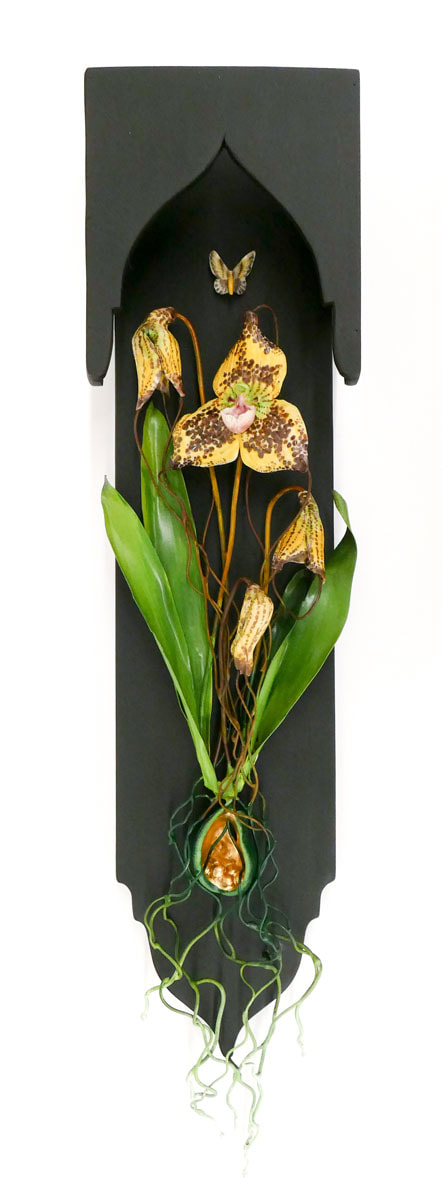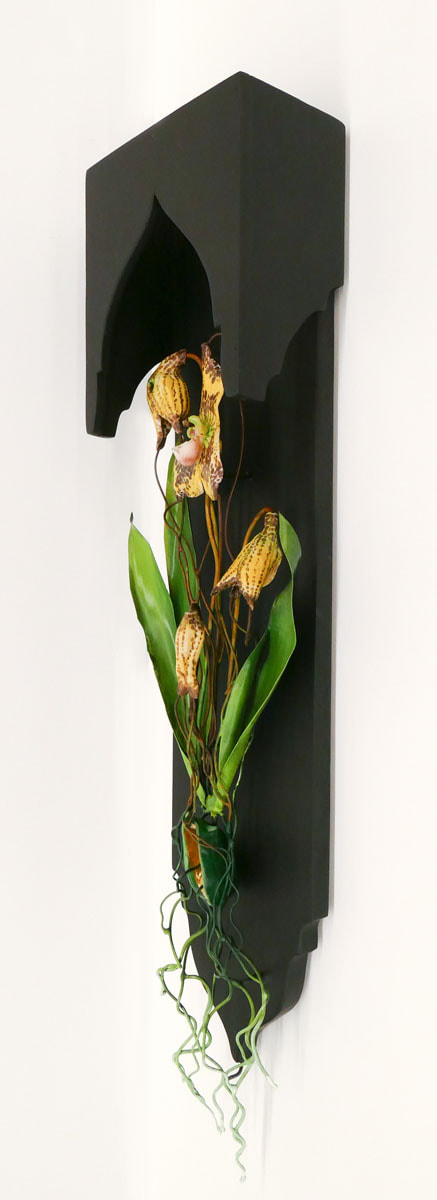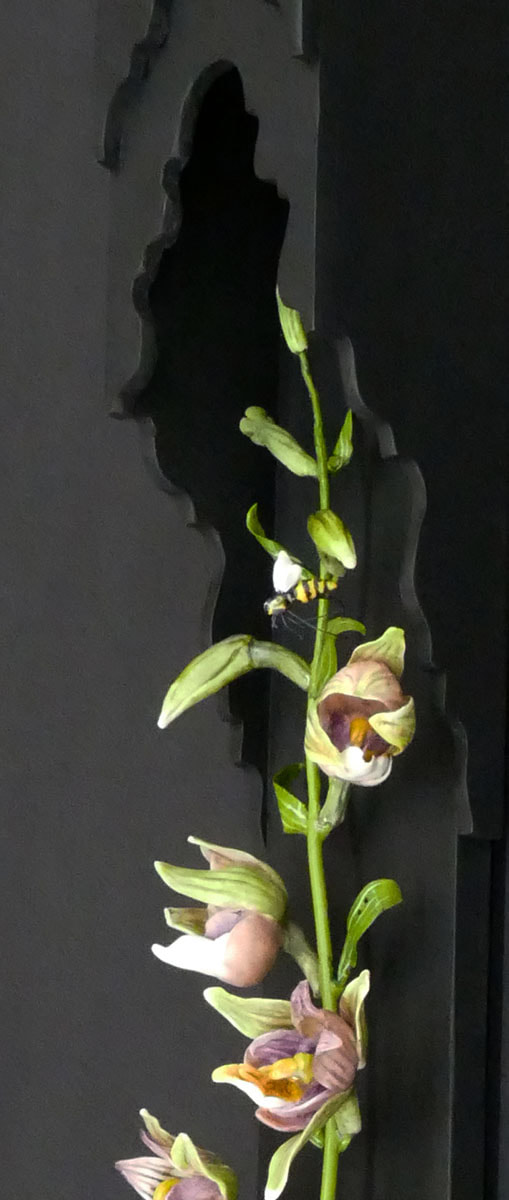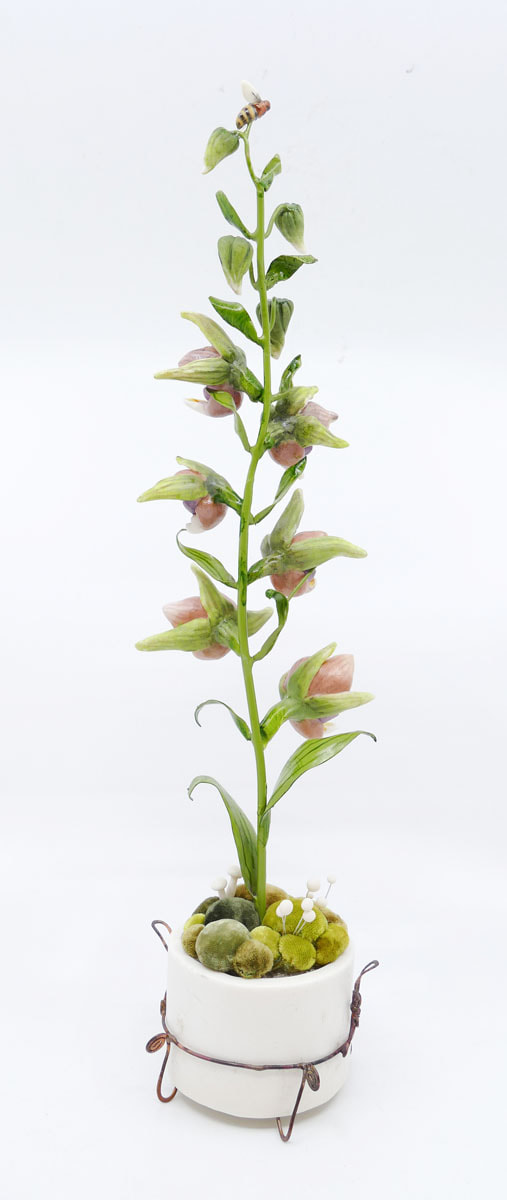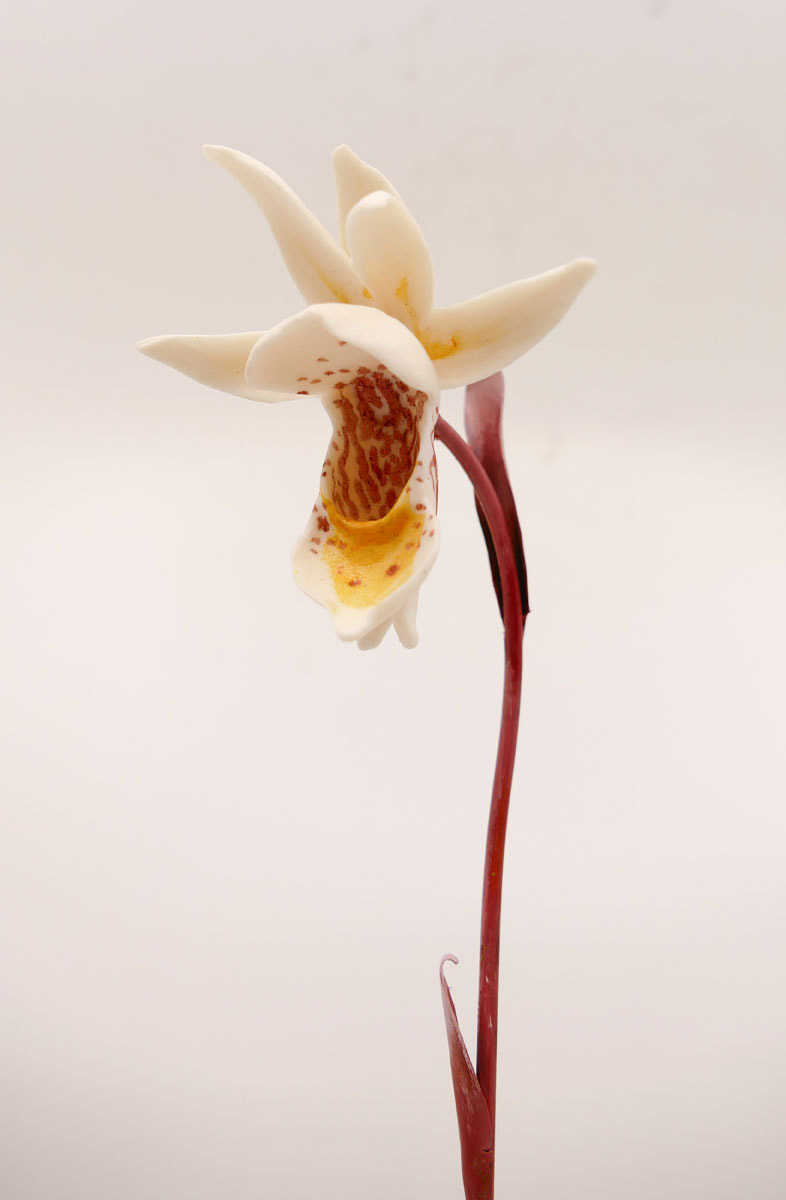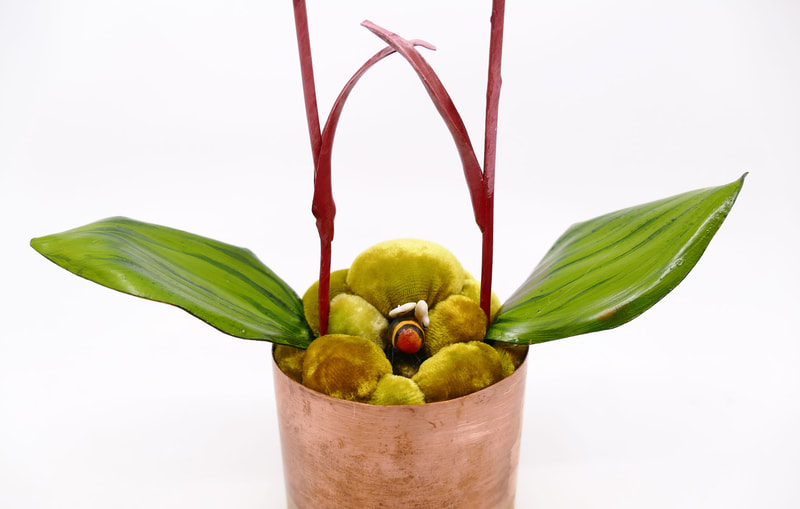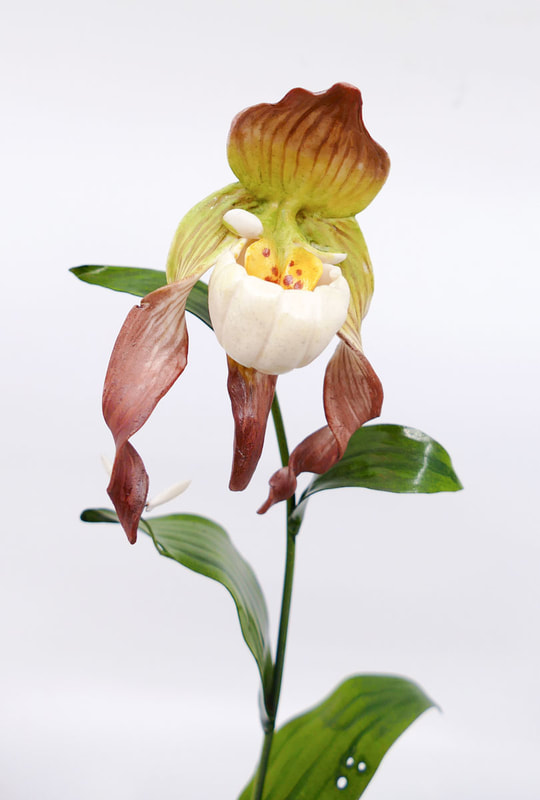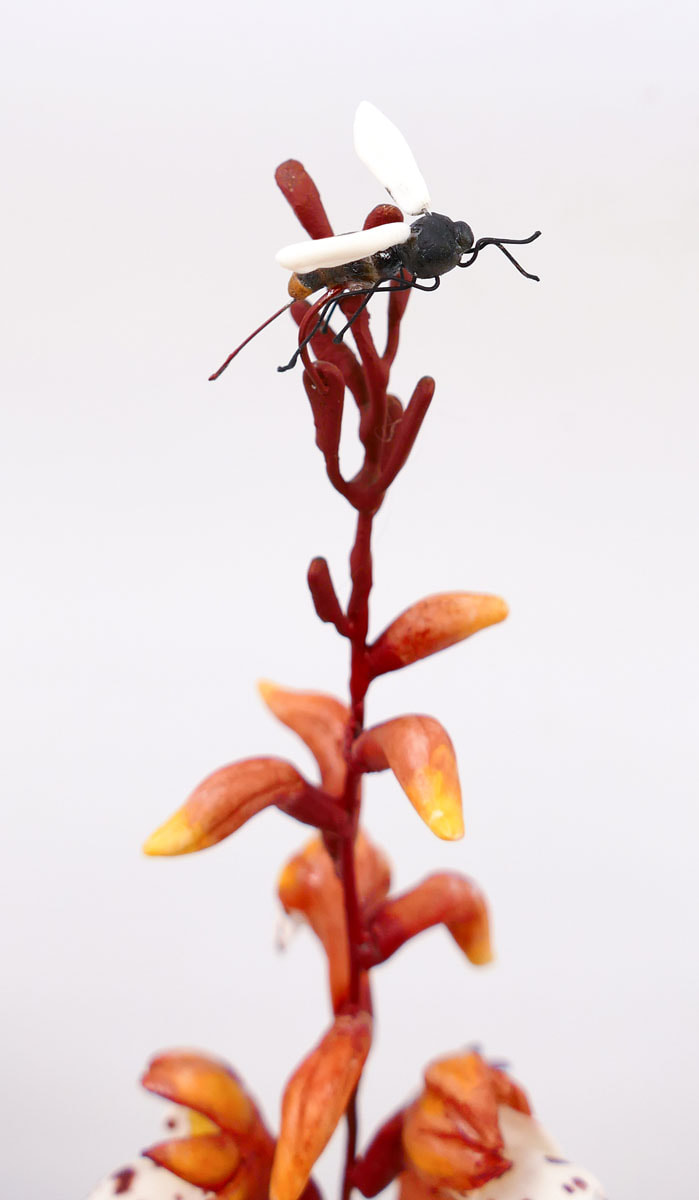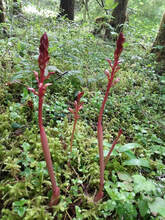Wild Orchids
A series of Native and Exotic orchids in porcelain
and copper. Find a few for sale at: Childhood's End Gallery in Olympia, WA
**coast down to bottom of page for slideshow
There are tiny orchids in our forests of the Northwest. Rare and unusual specimens that play
by different rules than their tropical relations. Most folks have yet to discover these unusual and delicate plants.
In our old growth forests we have diminutive Fairy orchids under 5 inches growing
deep in the moss. They use deceptive shape and scent to woo the early bumblebee queens to move their pollinia. The queens are deceived by the blooms which mimic pollinating flowers. They are drawn onto the yellow hairs of the fairie's lip and the pollinia drops onto their backs.
Coralroots and similar mycorrhizal feeders like Phantom orchids don't use chlorophyll, but utilize their fungus neighbors woven into the roots of trees. Long and thin these orchids have no leaves and often take years to bloom.
Moccasin flowers are what the native peoples of the Americas called this exotic orchid. Later it received the names of the Lady slipper or Mountain slipper. The shoe shaped lower lip is cupped and insects get trapped in order to delay their exit. The guests remain long enough stay to pick up pollinia for their journey to the next orchid.
The pollinators of these plants include hover flies, parasitical wasps, bees,
bumblebees, flies and other insects. I love insects of all sorts, so it was blissful to sculpt these tiny orchid partners. Often ignored, hated or sprayed to death, stinging insects are excellent pollinators and are as valuable as any butterfly or ladybug.
So explore your forests, see the orchids, and leave them to flourish and show off to the next visitor...
**PLEASE don't cut the flowers or disturb the plants. They are rare and can take years to bloom.
by different rules than their tropical relations. Most folks have yet to discover these unusual and delicate plants.
In our old growth forests we have diminutive Fairy orchids under 5 inches growing
deep in the moss. They use deceptive shape and scent to woo the early bumblebee queens to move their pollinia. The queens are deceived by the blooms which mimic pollinating flowers. They are drawn onto the yellow hairs of the fairie's lip and the pollinia drops onto their backs.
Coralroots and similar mycorrhizal feeders like Phantom orchids don't use chlorophyll, but utilize their fungus neighbors woven into the roots of trees. Long and thin these orchids have no leaves and often take years to bloom.
Moccasin flowers are what the native peoples of the Americas called this exotic orchid. Later it received the names of the Lady slipper or Mountain slipper. The shoe shaped lower lip is cupped and insects get trapped in order to delay their exit. The guests remain long enough stay to pick up pollinia for their journey to the next orchid.
The pollinators of these plants include hover flies, parasitical wasps, bees,
bumblebees, flies and other insects. I love insects of all sorts, so it was blissful to sculpt these tiny orchid partners. Often ignored, hated or sprayed to death, stinging insects are excellent pollinators and are as valuable as any butterfly or ladybug.
So explore your forests, see the orchids, and leave them to flourish and show off to the next visitor...
**PLEASE don't cut the flowers or disturb the plants. They are rare and can take years to bloom.
|
WILD ORCHIDS Loralin's current work echoes the naturalist eras of the past: times of explorative worship of the natural world and its tensions. The wild orchid series references orchids and their cycles with whimsy and wonder. The wall pieces are the Exotics, orchids from other states and continents. The pedestal sculptures are the native Northwest orchids. “My passion to create this year is inspired by the innocent mutualism of different plants and pollinators. Recently I personally discovered the native orchids here in the forests and was stunned into reverence. I only aspire to invoke their imagery. “ Her past work spans many symbolic and mythological themes, a foundation for her current botanical sculpture. Often the imagery reflects on insect cycles and predator/prey aspects playing out their dramas below beautiful flora. The simplicity and collaboration of nature suggests an evolution we as humans can aspire to. One may see similarities to the flower and underworld paintings of the 1600’s In Europe. Her experiences have paved the way to combining classic materials in detailed and diminutive combinations. Each Orchid artwork can take months to finish, and includes hundreds of components. Working in a difficult medium of translucent porcelain, she adds china paints and then formed copper foliage to suggest movement. Finishing with crystals and silk velvets they resonate with luxury and texture. Altogether they direct the viewer to reflect on the wonder of evolution in flora. Perhaps encouraging one to consider the tiny and often overlooked orchids of our area. The artist intends that the sculptures invoke your own precious moment of blissful adoration of something rare in the forest. |
All photos of the Wild Orchid Series are by Jeremy Buben, a fabulous curator of www.foodartcollection.com
All photos and images on www.loralin.com belong solely to the artist. Copyright 2008-2023, Loralin Toney










